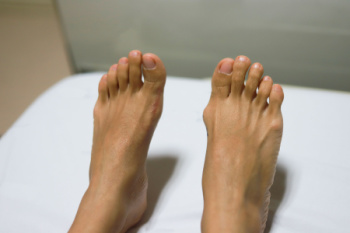
Non-surgical treatments for bunions focus on relieving pain and discomfort, as well as slowing down the progression of the condition. Treatments include wearing comfortable shoes with a wide toe box to reduce pressure on the bunion, using padded inserts or orthotic devices to provide support and cushioning, and resting the foot to reduce swelling and inflammation. Toe spacers or splints may be used to help realign the toes gradually. Stretching and strengthening exercises for the foot and toe muscles can also improve flexibility and stability. While these treatments may not correct the bunion entirely, they can alleviate symptoms and improve quality of life for individuals with bunions who wish to avoid surgery. If you have a bunion that is causing discomfort, it is suggested that you visit a podiatrist regularly to track its progression, and adjust treatment as needed.
If you are suffering from bunion pain, contact Bruce Smit, DPM of Frankfort Foot & Ankle Clinic. Our doctor can provide the care you need to keep you pain-free and on your feet.
What Is a Bunion?
Bunions are painful bony bumps that usually develop on the inside of the foot at the joint of the big toe. As the deformity increases over time, it may become painful to walk and wear shoes. Women are more likely to exacerbate existing bunions since they often wear tight, narrow shoes that shift their toes together. Bunion pain can be relieved by wearing wider shoes with enough room for the toes.
Causes
Symptoms
In order to diagnose your bunion, your podiatrist may ask about your medical history, symptoms, and general health. Your doctor might also order an x-ray to take a closer look at your feet. Nonsurgical treatment options include orthotics, padding, icing, changes in footwear, and medication. If nonsurgical treatments don’t alleviate your bunion pain, surgery may be necessary.
If you have any questions, please feel free to contact our office located in Frankfort, IL . We offer the newest diagnostic and treatment technologies for all your foot care needs.
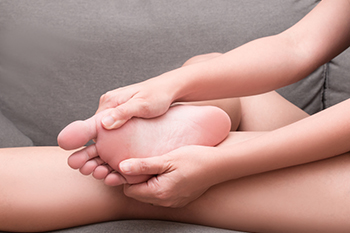
Sesamoid bones are small, specialized bones embedded within tendons, and play a critical role in the function of the feet. Positioned beneath the first metatarsal head, sesamoid bones provide leverage and support to the big toe, facilitating smooth movement and weight distribution during activities such as walking, running, and jumping. Despite their importance, sesamoid bones are prone to injury and inflammation, a condition known as sesamoiditis. Sesamoiditis typically occurs due to repetitive stress or trauma to the sesamoid bones, commonly seen in athletes engaging in activities that involve high-impact forces on the feet. Improper footwear, excessive pressure on the ball of the foot, and sudden increases in physical activity can also contribute to sesamoiditis. Symptoms of sesamoiditis include localized pain, swelling, and difficulty bearing weight on the affected foot. Recognizing the function of sesamoid bones and understanding the causes of sesamoiditis is essential for preventing and managing this painful condition. If you have any of the above symptoms, it is suggested that you schedule an appointment with a podiatrist who can accurately diagnose and treat sesamoiditis.
Sesamoiditis is an unpleasant foot condition characterized by pain in the balls of the feet. If you think you’re struggling with sesamoiditis, contact Bruce Smit, DPM of Frankfort Foot & Ankle Clinic. Our doctor will treat your condition thoroughly and effectively.
Sesamoiditis
Sesamoiditis is a condition of the foot that affects the ball of the foot. It is more common in younger people than it is in older people. It can also occur with people who have begun a new exercise program, since their bodies are adjusting to the new physical regimen. Pain may also be caused by the inflammation of tendons surrounding the bones. It is important to seek treatment in its early stages because if you ignore the pain, this condition can lead to more serious problems such as severe irritation and bone fractures.
Causes of Sesamoiditis
Treatment for sesamoiditis is non-invasive and simple. Doctors may recommend a strict rest period where the patient forgoes most physical activity. This will help give the patient time to heal their feet through limited activity. For serious cases, it is best to speak with your doctor to determine a treatment option that will help your specific needs.
If you have any questions please feel free to contact our office located in Frankfort, IL . We offer the newest diagnostic and treatment technologies for all your foot and ankle needs.
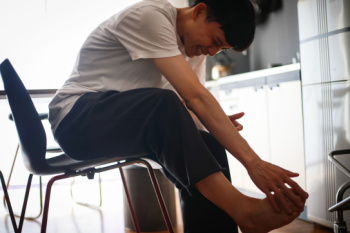
Gout is caused by the accumulation of uric acid crystals in joints, often affecting the big toe. Gout is notorious for its intense pain, which frequently flares up at night. Although commonly associated with men over 45, gout can develop in anyone at any age. This arthritic condition stems from the body's inability to adequately process purines, which are natural substances found in the body. This inability results in the formation of uric acid. When uric acid levels become elevated, sharp urate crystals form and deposit in joints, leading to inflammation, swelling, and excruciating pain. While the big toe is a frequent target, gout can affect any joint and often strikes suddenly, even disrupting sleep with its severity. Dietary factors play a significant role in gout development, with diets high in red meat, seafood, and fructose-containing beverages increasing the risk. Alcohol consumption and obesity also increase susceptibility to gout. Symptoms can include agonizing pain, swelling, warmth, and redness at the affected joint, which may last up to a week before subsiding. Gout is not curable, but it can be managed with the help of lifestyle and dietary changes and treatment from a podiatrist. If you suffer from the symptoms of gout, it is suggested that you are under the care of a podiatrist who is medically trained to manage this ailment.
Gout is a foot condition that requires certain treatment and care. If you are seeking treatment, contact Bruce Smit, DPM from Frankfort Foot & Ankle Clinic. Our doctor will treat your foot and ankle needs.
What Is Gout?
Gout is a type of arthritis caused by a buildup of uric acid in the bloodstream. It often develops in the foot, especially the big toe area, although it can manifest in other parts of the body as well. Gout can make walking and standing very painful and is especially common in diabetics and the obese.
People typically get gout because of a poor diet. Genetic predisposition is also a factor. The children of parents who have had gout frequently have a chance of developing it themselves.
Gout can easily be identified by redness and inflammation of the big toe and the surrounding areas of the foot. Other symptoms include extreme fatigue, joint pain, and running high fevers. Sometimes corticosteroid drugs can be prescribed to treat gout, but the best way to combat this disease is to get more exercise and eat a better diet.
If you have any questions please feel free to contact our office located in Frankfort, IL . We offer the newest diagnostic and treatment technologies for all your foot and ankle needs.
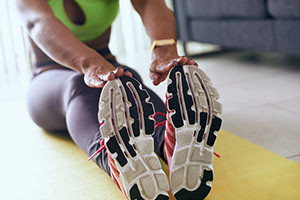
Embarking on a running journey is a pursuit of both physical fitness and mental well-being. To ensure a sustained and injury-free experience, incorporating preventive measures into your running routine is paramount. A key way to prevent running injuries is to begin with a dynamic warm-up routine, encompassing stretches that target key muscle groups. Consistent strength training that focuses on the core and lower body fortifies the muscles, reducing the risk of overuse injuries in the feet. Investing in quality footwear that suits your foot type and running terrain is a cornerstone of injury prevention. Gradual progression in mileage and intensity allows the body to adapt, minimizing the strain on foot's many muscles and joints. Listening to your body and recognizing early signs of fatigue or discomfort enables timely adjustments to prevent injuries. Post-run stretches that emphasize flexibility aid in muscle recovery and maintain joint suppleness. By integrating these strategies, runners can safeguard against injuries and nurture flexibility, fostering a sustainable and fulfilling running experience. If you are experiencing foot or ankle injuries related to running, it is suggested that you make an appointment with a podiatrist.
All runners should take extra precaution when trying to avoid injury. If you have any concerns about your feet, contact Bruce Smit, DPM of Frankfort Foot & Ankle Clinic. Our doctor will treat your foot and ankle needs.
How to Prevent Running Injuries
There are a lot of mistakes a runner can make prior to a workout that can induce injury. A lot of athletes tend to overstretch before running, instead of saving those workouts for a post-run routine. Deep lunges and hand-to-toe hamstring pulls should be performed after a workout instead of during a warmup. Another common mistake is jumping into an intense routine before your body is physically prepared for it. You should try to ease your way into long-distance running instead of forcing yourself to rush into it.
More Tips for Preventing Injury
If you have any questions, please feel free to contact our office located in Frankfort, IL . We offer the newest diagnostic and treatment technologies for all your foot care needs.

Debridement wound care is often necessary for the proper healing and prevention of complications in foot wounds. Debridement, whether with special dressings, maggots, or mechanical methods, aids in removing dead or infected tissue and facilitates healing. After this procedure, it is important to regularly change the dressing, as per your podiatrist’s instructions. Keeping the dressing dry by avoiding activities like swimming or hot tubs is vital. Always maintain cleanliness by washing your hands before and after touching the wound. Avoid applying pressure and use cushions or crutches, if necessary. While debridement carries potential risks like irritation, bleeding, or infection, its benefits often outweigh these. Pay attention to signs of infection, such as increasing pain, redness, swelling, or fever. If you have foot wounds or have had a debridement procedure and healing is slower than expected or shows signs of infection, it is strongly suggested that you schedule an appointment with a podiatrist for care.
Wound care is an important part in dealing with diabetes. If you have diabetes and a foot wound or would like more information about wound care for diabetics, consult with Bruce Smit, DPM from Frankfort Foot & Ankle Clinic. Our doctor will assess your condition and provide you with quality foot and ankle treatment.
What Is Wound Care?
Wound care is the practice of taking proper care of a wound. This can range from the smallest to the largest of wounds. While everyone can benefit from proper wound care, it is much more important for diabetics. Diabetics often suffer from poor blood circulation which causes wounds to heal much slower than they would in a non-diabetic.
What Is the Importance of Wound Care?
While it may not seem apparent with small ulcers on the foot, for diabetics, any size ulcer can become infected. Diabetics often also suffer from neuropathy, or nerve loss. This means they might not even feel when they have an ulcer on their foot. If the wound becomes severely infected, amputation may be necessary. Therefore, it is of the upmost importance to properly care for any and all foot wounds.
How to Care for Wounds
The best way to care for foot wounds is to prevent them. For diabetics, this means daily inspections of the feet for any signs of abnormalities or ulcers. It is also recommended to see a podiatrist several times a year for a foot inspection. If you do have an ulcer, run the wound under water to clear dirt from the wound; then apply antibiotic ointment to the wound and cover with a bandage. Bandages should be changed daily and keeping pressure off the wound is smart. It is advised to see a podiatrist, who can keep an eye on it.
If you have any questions, please feel free to contact our office located in Frankfort, IL . We offer the newest diagnostic and treatment technologies for all your foot care needs.
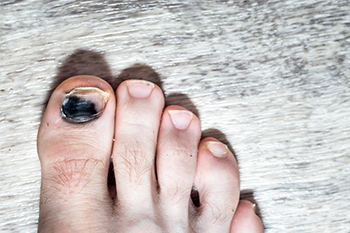
Blackened toenails are caused by repetitive pressure and friction, often occurring when the toe is forced against the front edge of a shoe's toe box. While sometimes referred to as tennis toe, blackened toenails can also affect athletes in soccer, football, squash, racquetball, basketball, running, and skiing. Symptoms include throbbing pain and a reddish-blue or black discoloration of the nail plate due to a subungual hematoma, which is caused by blood under the nail. The big toe is more commonly affected in blackened toenails, but the second toe may also be affected. Wearing ill-fitting shoes plays a pivotal role, causing friction that leads to bleeding under the toenail. In severe cases with significant bleeding, swelling, or infection, visiting a podiatrist is suggested. This foot doctor may relieve pressure on the subungual hematoma by making a small hole in the nail or, in extreme cases, recommend partial or complete nail removal. Prevention involves wearing well-fitted shoes and recognizing early symptoms. Whether you are an avid athlete or enjoy an active lifestyle, if you notice discoloration in the toenails, it is suggested that you schedule an appointment with a podiatrist for treatment solutions.
Toe pain can disrupt your daily activities. If you have any concerns, contact Bruce Smit, DPM of Frankfort Foot & Ankle Clinic. Our doctor can provide the care you need to keep you pain-free and on your feet.
What Causes Toe Pain?
Most severe toe pain is caused due to a sports injury, trauma from dropping something heavy on the toe, or bumping into something rigid. Other problems can develop over time for various reasons.
Toe pain can be caused by one or more ailments. The most common include:
When to See a Podiatrist
Diagnosis
In many cases the cause of toe pain is obvious, but in others, a podiatrist may want to use more advanced methods to determine the problem. These can range from simple visual inspections and sensation tests to X-rays and MRI scans. Prior medical history, family medical history, and any recent physical traumatic events will all be taken into consideration for a proper diagnosis.
Treatment
Treatments for toe pain and injuries vary and may include shoe inserts, padding, taping, medicines, injections, and in some cases, surgery. If you believe that you have broken a toe, please see a podiatrist as soon as possible.
If you have any questions please feel free to contact our office located in Frankfort, IL . We offer the newest diagnostic tools and technology to treat your foot and ankle needs.
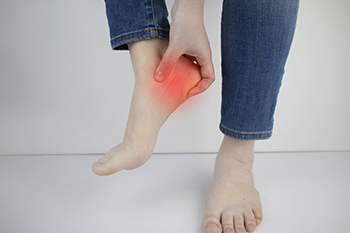
Plantar fasciitis, a prevalent foot condition, unfolds as a result of inflammation in the plantar fascia, a thick band of tissue that spans the bottom of the foot. This inflammation leads to symptoms that are distinctive yet often underestimated. A primary symptom is heel pain, particularly felt during the initial steps after periods of rest. The discomfort may also escalate after prolonged periods of standing or intense physical activity. The causes of plantar fasciitis are commonly rooted in excessive strain on the plantar fascia, due to activities like running, standing for extended periods, or inadequate footwear. Weight gain, tight calf muscles, and certain biomechanical issues can also contribute to the development of this condition. Recognizing the nuanced interplay of symptoms and causes is essential for prompt diagnosis and the implementation of effective strategies to alleviate pain. If you have heel pain, it is suggested that you consult a podiatrist for a diagnosis and an appropriate treatment plan.
Plantar fasciitis is a common foot condition that is often caused by a strain injury. If you are experiencing heel pain or symptoms of plantar fasciitis, contact Bruce Smit, DPM from Frankfort Foot & Ankle Clinic. Our doctor can provide the care you need to keep you pain-free and on your feet.
What Is Plantar Fasciitis?
Plantar fasciitis is one of the most common causes of heel pain. The plantar fascia is a ligament that connects your heel to the front of your foot. When this ligament becomes inflamed, plantar fasciitis is the result. If you have plantar fasciitis you will have a stabbing pain that usually occurs with your first steps in the morning. As the day progresses and you walk around more, this pain will start to disappear, but it will return after long periods of standing or sitting.
What Causes Plantar Fasciitis?
There are some risk factors that may make you more likely to develop plantar fasciitis compared to others. The condition most commonly affects adults between the ages of 40 and 60. It also tends to affect people who are obese because the extra pounds result in extra stress being placed on the plantar fascia.
Prevention
There are a variety of treatment options available for plantar fasciitis along with the pain that accompanies it. Additionally, physical therapy is a very important component in the treatment process. It is important that you meet with your podiatrist to determine which treatment option is best for you.
If you have any questions, please feel free to contact our office located in Frankfort, IL . We offer the newest diagnostic and treatment technologies for all your foot care needs.
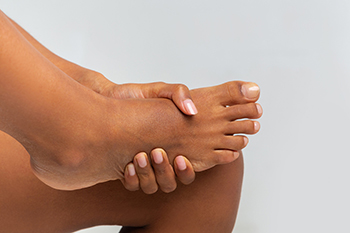
For most people over the age of 50, foot pain is a common experience, affecting approximately 20 percent of older adults. Contributing factors include excess weight, inappropriate footwear, and the natural wear and tear associated with aging. However, it is essential not to dismiss foot pain, as research suggests it can compromise balance and foot function, and increase the risk of falls. Distinguishing between muscle soreness from activity and sharp pain originating from bones or joints is important. If experiencing the latter, seeking help from a medical professional is imperative. Several types of foot pain warrant such attention. Stress fractures, prevalent in older adults, manifest as pain during activity that subsides with rest. Persistent heel pain, such as plantar fasciitis, may require evaluation from a podiatrist if it persists despite rest. Psoriatic arthritis, characterized by joint pain and swelling, often accompanied by psoriasis symptoms, requires attention. Neuropathy, frequently linked to diabetes but with various causes, demands investigation for symptoms like tingling, burning, or foot numbness. If you are experiencing persistent or sharp foot pain it is suggested that you schedule an appointment with a podiatrist for a diagnosis and tailored treatment plan.
Foot Pain
Foot pain can be extremely painful and debilitating. If you have a foot pain, consult with Bruce Smit, DPM from Frankfort Foot & Ankle Clinic. Our doctor will assess your condition and provide you with quality foot and ankle treatment.
Causes
Foot pain is a very broad condition that could be caused by one or more ailments. The most common include:
Diagnosis
To figure out the cause of foot pain, podiatrists utilize several different methods. This can range from simple visual inspections and sensation tests to X-rays and MRI scans. Prior medical history, family medical history, and any recent physical traumatic events will all be taken into consideration for a proper diagnosis.
Treatment
Treatment depends upon the cause of the foot pain. Whether it is resting, staying off the foot, or having surgery; podiatrists have a number of treatment options available for foot pain.
If you have any questions, please feel free to contact our office located in Frankfort, IL . We offer the newest diagnostic and treatment technologies for all your foot care needs.

Embarking on a journey of fitness or leisure requires thoughtful consideration of the right footwear, and understanding the differences between walking and running shoes is pivotal. Walking shoes, designed for a heel to toe rolling motion, prioritize flexibility and stability. Their soles are crafted to absorb shock during the natural heel-strike phase of walking. Conversely, running shoes cater to a more dynamic gait, with features such as enhanced cushioning and support for the midsole and forefront. The structure of running shoes accommodates the impact and propulsion associated with a runner's stride. Recognizing these distinctions ensures that you provide your feet with the appropriate support for the activity at hand. Whether you are strolling through the park or pounding the pavement during a jog, investing in the right footwear not only optimizes performance but also safeguards against potential discomfort or injury, For guidance in choosing the proper walking and running shoes, it is suggested that you schedule an appointment with a podiatrist.
For more information about walking shoes versus running shoes, consult with Bruce Smit, DPM from Frankfort Foot & Ankle Clinic. Our doctor can measure your feet to determine what your needs are and help you find an appropriate pair of footwear.
Foot Health: The Differences between Walking & Running Shoes
There are great ways to stay in shape: running and walking are two great exercises to a healthy lifestyle. It is important to know that running shoes and walking shoes are not interchangeable. There is a key difference on how the feet hit the ground when someone is running or walking. This is why one should be aware that a shoe is designed differently for each activity.
You may be asking yourself what the real differences are between walking and running shoes and the answers may shock you.
Differences
Walking doesn’t involve as much stress or impact on the feet as running does. However, this doesn’t mean that you should be any less prepared. When you’re walking, you land on your heels and have your foot roll forward. This rolling motion requires additional support to the feet.
Flexibility – Walking shoes are designed to have soft, flexible soles. This allows the walker to push off easily with each step.
If you have any questions, please feel free to contact our office located in Frankfort, IL . We offer the newest diagnostic and treatment technologies for all your foot care needs.